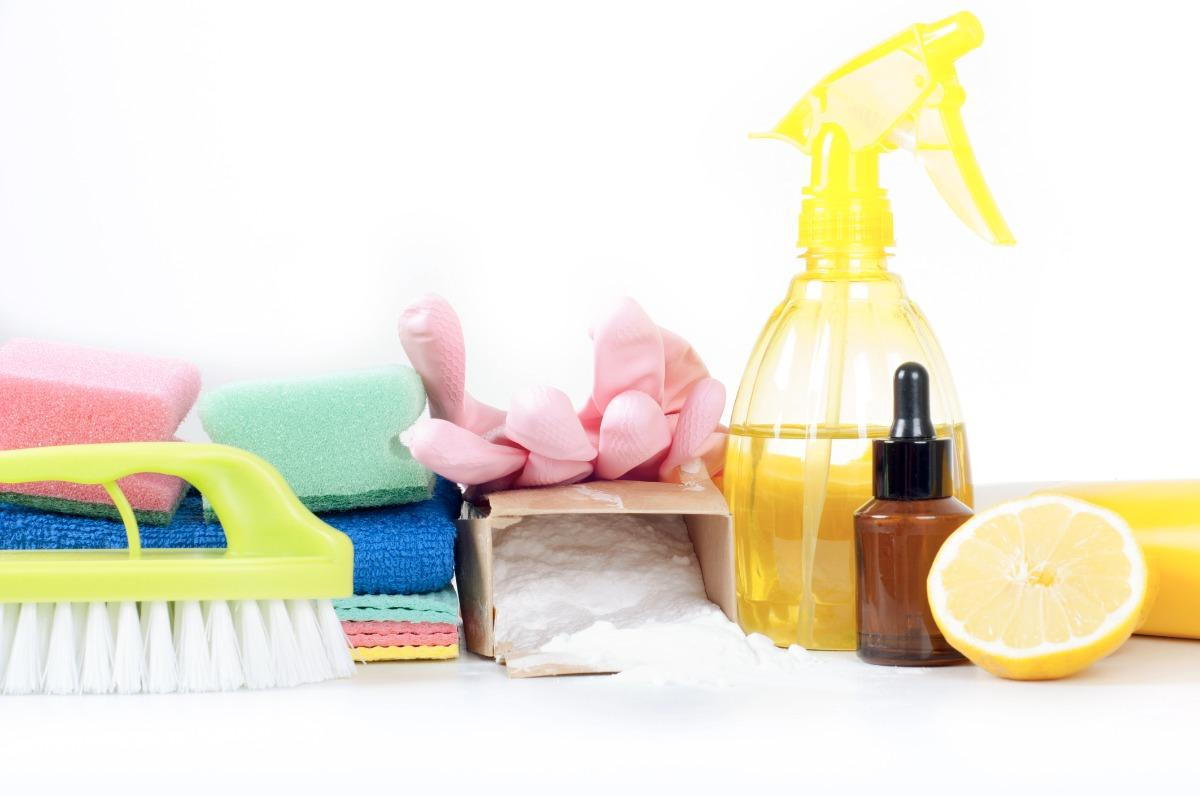
1. Mix ingredients together and pour into a spray bottle.Today's guest post comes from the Wellness Chef, whose passion is creating insanely delicious food from all natural, allergen-free ingredients. You can find the original post at her blog, TheDeliciousThings.com.
For years I've had a thing. I've loved walking in to a recently cleaned room that smelled of bleach. Oh sure, my nostrils would burn, but in direct proportion to the degree to which my face was on fire I’d feel this satisfying sense that everything around me was sterile. I could eat off this floor! As much as this catch phrase makes me laugh, I'll admit there's something comforting about being in a perfectly sanitized environment.
All of that changed the day I walked into a space that smelled like lavender and tea tree oil. It was subtle and oh-so-pleasant, a stark contrast to the nose hair-singeing experiences of my past. So imagine my surprise to discover that this room was just as sterile as the bleach-soaked example above.
So in the latest installment of tiny-changes-you-can-make-that-will-impact-your-life-in-a-big-way, I want to ask you, dear reader: If you could get the same cleaning efficacy from all-natural, non-toxic products, would you make the switch?
The Big Why
I hear people joke that everything causes cancer. Pesticides, air pollutants, skincare chemicals, plastics, food additives, and industrial compounds are just a few that come to mind. That sentiment is usually piggybacked by some variation of the following: Womp womp, it’s all just a lost cause.
I beg to differ, however. If we are exposed to cancer- and other disease causing-toxins day in and day out, shouldn't we try to eliminate as many as we can control? Let us not throw our hands up in the air and proclaim keeping ourselves healthy an impossible task. Let us instead come from the perspective that every little bit matters.
Are They Really That Dangerous?
Environmental experts say the average household contains 62 toxic chemicals. Typical cleaning products have been linked to acute hazards such as chemical burns and respiratory irritation, as well as chronic effects like asthma, cancer, reproductive disorders, neurotoxicity and hormone disruption.
Let’s look at just one of these long-term effects more closely. Hormone disruptors either block messages the body is sending or mimic the hormones themselves. So we’re talking a high possibility of male birth defects and greater incidence of breast cancer as a potential cost of refusing to throw out your Clorox. Yikes.
Of course manufacturers argue that modest amounts of exposure to their products isn’t likely to be a problem, but what about the notion that frequent use of these chemicals adds to the body’s toxic burden--aka the number of chemicals stored in its tissues at a given time? It follows logic that consistent exposure has a cumulative effect.
And if that’s not scary enough, these same chemicals change the way our immune cells function, which regulates our reactions (or over-reactions) to the foods we eat. This indicates that exposure to toxins could be a major cause of the unprecedented increase in celiac disease and food intolerance.
But Is All-Natural Really Effective?
The US National Library of Medicine published a study showing that certain plant essential oils, including those from lavender, had antibacterial and antimicrobial properties that were effective against salmonella, E. coli bacteria and even some strains of staph. The first two are the most common strains of food-borne bacteria, so if my Lavender Antibacterial Spray recipe can combat those, it's ideal for use in my kitchen. (1)
Author Annie Hauser did a trial run of homemade cleaners versus corporate chemicals and had this to say: "On the whole, homemade cleaning products are worth the effort. Not only do they save money, but also they can provide the same cleaning power as store-bought brands without harsh chemicals like bleach or ammonia. Plus, despite what advertisers want you to think, you really can use the same natural products for multiple surfaces around your home." (2)
I've been using all-natural cleaners in my home for well over three years now and I've been thrilled with the results. But don't take my word for it...it's high time you see for yourself.
All Right, How Much is This Gonna Cost Me?
All of the ingredients in the recipes listed below can be acquired at your local grocery store and at online retailers. Buy them once and they will last a ridiculously long time—and as an added bonus, the cost savings will boggle your mind. An initial investment of about $30 will bring the cost of your cleaning supplies to mere cents per bottle over the lifetime of the ingredients.
It Sounds Like a Lot of Work
Trust me, it isn’t. Twenty minutes or so is all it takes to make all your products the first time, and then plan on about five minutes to throw together a refill. I use a label on each bottle large enough to include the recipe along with the cleaner’s name, so I don't waste any time looking up what ingredients I need.
The five recipes that follow are sure to cover 95% of your home cleaning needs. I have yet to try a floor cleaner, wood polisher or laundry detergent that I love, but I will update when I do.
All-Purpose Cleaner
Prep time: 5 mins
Yield: 2 cups
Since this gets near constant use in my house, I double this recipe and put it in a commercial-sized spray bottle.
Ingredients
• 2 cups hot water
• 3 T vinegar
• 1/2 tsp washing soda
• 1/2 tsp castile soap
Instructions
1. Mix all ingredients together in a large bowl to account for a LOT of foaming.
2. Pour into a spray bottle.
Lavender Antibacterial Spray
Prep time: 5 mins
Yield: 2 cups
This super easy antibacterial spray smells amazing!
Ingredients
• 2 cups water
• Approximately 40 drops lavender essential oil
Instructions
1. Mix ingredients together and pour into a spray bottle.
De-greaser
Prep time: 5 mins
Yield: 2 cups
Works like a charm on the stove top. Wipe with a slightly damp towel after using to remove all soap residue.
Ingredients
• 2 cups water
• 1/2 cup castile soap
• 10 drops lavender essential oil
Instructions
1. Mix ingredients together and pour into a spray bottle.
Bathroom and Tile Cleanser
Prep time: 5 mins
Yield: 1.5 cups
This creates a paste, so use a squirt bottle or a tub for storing. It also settles as it sits, so it needs to be well shaken before use, and occasionally requires more water to reconstitute the paste.
Ingredients
• 1/2 cup water
• 2/3 cup baking soda
• 1/2 cup castile soap
• 2 T vinegar
• 5 drops tea tree oil
Instructions
1. Mix all ingredients together in a large bowl to account for foaming.
2. Pour into a squirt bottle or tub for storing.
Glass Cleaner
Prep time: 5 mins
Yield: 2.5 cups
Shake this one well before using. And for super streak-free windows, use newspaper for wiping.
Ingredients
• 2 cups hot water
• 1/4 cup rubbing alcohol
• 1/4 cup vinegar
• 1 T cornstarch
Instructions
